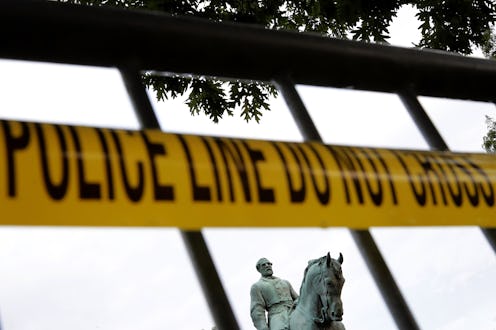News
How To Stay Safe At A Protest

On Saturday, a car was purposely driven into a crowd of people protesting the racist, White Supremacist-led "Unite the Right" rally in Charlottesville, VA. At least 19 were injured in the crash, one woman died, and a state of emergency was declared following the chaos. On top of the deadly car strike, several skirmishes erupted throughout the day, and two state police officers died in a helicopter crash that night. In light of recent events, staying safe at a protest is an important concern for those who want to publicly exercise their right to free speech, and fight back against the hatred being spewed by Alt-right groups. There's no way to predict the future, but by preparing ahead of time and staying aware of your surroundings, it's possible to reduce the level of risk associated with protests and rallies.
Between Saturday's violence and the numerous terrorist incidents that have taken place in 2017 alone, it's natural to be concerned about safety during a protest — especially while one is attempting to carry out free speech, and fight back against hatred, bigotry, and racism. While demonstrations always carry some risks, there are ways to prepare, whether you're a first-timer or a seasoned protester.
Know Your Rights
Like it or not, people are sometimes arrested at rallies. Familiarize yourself with local law enforcement agencies and their jurisdiction. Be sure to also understand your own rights in the country where you're protesting. If you feel your rights have been violated, the American Civil Liberties Union (ACLU) has a guide for what to do next.
Carry Your Medication & ID
If you take medication, bring several days' worth of supplies with you to the protest, so you won't run out in the event things go on longer than you expect. Be sure to bring a form of identification as well.
Check Out A Map
Familiarize yourself with a map of the area. Be aware of your surroundings — not just the site of the protest, but side streets and nearby landmarks.
Pack A First Aid Kit
Take a cue from the Boy Scouts and always be prepared. Bring a first aid kit to the rally, so you can patch up minor problems from bee stings to scrapes. The Red Cross has a suggested list of items on its website.
Bring Water
As Amnesty International notes, water isn't just important for hydration; it can also be used to rinse out eyes or wash off skin. (The organization also advises against wearing contacts or lotions, both of which can trap irritating chemicals.)
Charge Your Phone
Phones have proven incredibly useful in documenting violence at protests, and they're an excellent way to keep in touch with your fellow protesters. (According to the ACLU, if you're lawfully present in a public space, you're legally allowed to photograph and record "anything that is in plain view.") Make sure your phone is charged; you might even want to bring rechargeable batteries, since finding an outlet may be tough.
Just in case, though, memorize (or simply write down) important numbers, especially that of your emergency contact.
Set Up A Meeting Spot
That being said, don't assume your phone will work. Set up a meeting spot in case members of your group get separated, and make a schedule so you'll have an idea of where everyone is supposed to be at certain times.
Stay Calm
Finally, stay calm and keep an eye on the crowd; if someone starts to panic, Amnesty International recommends calming them down as soon as possible. If you spot any warning signs or feel uncomfortable, you may want to remove yourself from the situation.
Protests are an important part of exercising your right to free speech, and with some planning, you can do your part to stay safe — and keep others safe as well.